Here’s how to profit from Asia’s infrastructure boom

Asia is growing – fast. The continent is home to many of the world's fastest growing economies. Rural Asia is moving to the cities at a rapid clip. And the region is home to an ever-increasing proportion of the world's middle class. What all this development means is that epic sums of money will need to be spent on expanding and improving Asia's infrastructure. Infrastructure is a critical ingredient of economic growth. More roads and railways, improved access to clean water, and better communication networks are just a few building blocks of infrastructure critical to support development. As I recently wrote, infrastructure is going to be one of the biggest investment themes of our lives. And there are few places in the world where infrastructure spending will be more crucial than in Asia, considering the rise of megacities in the region. Go to the city, young people One of the most crucial factors for this trend is the rate at which rural Asians are moving to cities. Last year, the United Nations projected that by 2018 for the first time ever, over half of the Asia-Pacific's population will be living in urban areas. And by 2050, China and India alone will see their numbers of city dwellers explode by nearly 700 million. That's over a quarter of their total current combined populations. The UN projects that the number of Asia-Pacific "megacities" – cities with more than 10 million inhabitants – to increase from 17 to 22 by 2030. In 2030, India's largest city, Mumbai, will have an economy larger than Malaysia's was two years ago. Rapid urbanisation in Asia is prompting the demand for high-quality infrastructure. This is likely to take the form of more and better public transport services, power generation facilities, telecommunications networks, and water and sanitation facilities, as well as more social infrastructure such as schools and hospitals. Mind the (infrastructure) gap Without significant investment, an "infrastructure gap" – the difference between what exists, and what's needed – will restrict economic growth. Without sufficient roads, goods can't be transported. Power outages destroy productivity. Unclean facilities make people sick. Investment projections for Asia alone are mind-boggling. The Asian Development Bank (ADB) estimated in 2010 that US$8 trillion would need to be spent on infrastructure projects between 2010 and 2020 just so the region would be able to maintain the same economic growth rate. Four years later, professional services firm PricewaterhouseCoopers estimated that US$800 billion-US$1.3 trillion in infrastructure would be required every year during 2015-2020.

China and Japan take the lead China and Japan are taking the lead in responding to Asia's thirst for infrastructure. In January, China launched the Asian Infrastructure Investment Bank (AIIB), a multilateral development bank with the mandate to invest in infrastructure, in Asia and worldwide. The 58 founding members of the AIIB have committed a total of US$100 billion in capital (30% of which has come from China). Last year Japan launched its own infrastructure investment initiative, the "Partnership for Quality Infrastructure". In collaboration with the ADB, the project aims to provide US$110 billion for infrastructure development across the world over the following 5 years. In June, Prime Minister Shinzo Abe pledged to increase the effort's financing to US$100 billion. But government support and capital will not be enough. Private players will have to get involved to push the region forward. The importance of PPPs PwC estimated in 2014 that the Asia-Pacific infrastructure market would grow by 7-8 percent per year to reach US$5.36 trillion annually by 2025. That's about the same as the combined GDP of the UK and France. And it will represent almost 60 percent of the world's total infrastructure expenditure during the period. So the efforts from governments alone won't come close to plugging Asia's growing infrastructure gap. Huge investment will also be required from private sector companies. One particular type of initiative that is increasingly popular in Asia is Public-Private Partnerships (PPPs). These are joint ventures in public infrastructure projects between a government and private investors. The private side usually finances the construction costs, and receives a return on its investment through the project's revenues. Once this targeted return is achieved, ownership of the asset is usually transferred to the public. Where's the opportunity?
The easiest way to gain exposure to infrastructure growth is through ETFs. The iShares Emerging Markets Infrastructure ETF (Nasdaq: EMIF) tracks the S&P Emerging Markets Infrastructure Index, which contains a basket of infrastructure companies operating in emerging markets, with a focus on industrials, utilities and energy firms. EMIF is dominated by holdings in Chinese companies (30% of total holdings), while Korea, Malaysia, Thailand, Hong Kong and the Philippines are all in the top 10. With $46 million of assets under management, the fund is relatively small, and has posted a return of 16% in 2016 so far. It's probably the easiest way to tap in to Asia's enormous thirst for infrastructure.

Kim Iskyan

 Yahoo Finance
Yahoo Finance 
